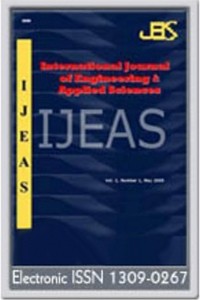Effects of Coating Aggregates on Dynamic Properties of Concrete by Impact Resonance Method
Effects of Coating Aggregates on Dynamic Properties of Concrete by Impact Resonance Method
Concrete structures may be subjected to dynamic loadings like earthquakes, impact, and vehicular loads. These loads may cause considerable damage to infrastructures and shorten their life span. To reduce the effects, improving concrete’s dynamic properties is important. This can be done using granular elastic components and fibers in the production of concrete. This research explores the influence of using coated aggregates on the physical, mechanical, and dynamic properties of concrete. Experimental investigation on concrete with epoxy, epoxy-sand, and epoxy-crumb rubber as a partial replacement of coarse aggregates at different volume fractions ranging from 5% to 20% was conducted. Furthermore, the dynamic modulus of elasticity of concrete with coated aggregate was determined by measuring the resonant frequencies of flexural vibrations in a prismatic beam using an impactor (hammer). Results indicate that partial replacement of epoxy-crumb rubber coated aggregates in concrete shows a reduction in mechanical proprieties. However, significant improvements in the mechanical and dynamic properties of concrete were observed by the partial replacement of coarse aggregates with epoxy and epoxy-sand coated aggregates. Compressive strength and dynamic elastic modulus were enhanced by 12% and 10%, respectively, when concrete with 15% epoxy-sand coated was used. The results showed that concrete specimens using epoxy and epoxy-sand coated as a partial replacement for coarse aggregate have higher mechanical properties as compared to those of concrete specimens with epoxy-crumb rubber-coated aggregates. Moreover, the results showed that the calculated values of the dynamic modulus of concrete using the empirical relations proposed by Popovics and Hansen were overestimated as compared to the experimental values.
Keywords:
epoxy-sand coated, epoxy-crumb rubber coated, resonant frequencies, flexural vibrations, dynamic modulus,
___
- Lu, Song, Jin-Yu Xu, Er-Lei Bai, Xin Luo., Effect of Particles with different Mechanical Properties on the Energy Dissipation Properties of Concrete. Construction and Building Materials, 144, 502-515, 2017.
- Sakthivel, S.N., Kathuria, A., Singh, B., Utilization of Inferior Quality Aggregates in Asphalt Mixes: A Systematic Review. Journal of Traffic and Transportation Engineering, 9(5), 864-879, 2022.
- Shahedan, Noor Fifinatasha, Mohd Mustafa., Potential of Geopolymer Coating for Lightweight Aggregate via Milling and Dipping Method: A Review. European Journal of Materials Science and Engineering, 7(2), 094–105, 2022.
- Lim, T., Lee, J.H., Mun, J.H., Yang, K.H., Ju, S., Jeong, S.M., Enhancing Functionality of Epoxy–TiO2-Embedded High-Strength Lightweight Aggregates. Polymers, 12(10), 1-11, 2020.
- Abutaha, F., Abdul Razak, H., Ibrahim, H.A., Effect of Coating Palm Oil Clinker Aggregate on the Engineering Properties of Normal Grade Concrete. Coatings, 7(10), 1-26, 2017.
- Muñoz Jose F., Expanded Study on the effects of Aggregate Coating and Films on Concrete Performance, Wisconsin highway research program, 2007.
- Muñoz, Jose F., M. Isabel Tejedor, Marc A. Anderson, and Steven M. Cramer., Detection of aggregate clay coatings and impacts on concrete. ACI Materials Journal, 107(4), 387-395, 2010.
- Rajasekaran, S., Vasudevan, R., Paulraj, S., Reuse of Waste Plastics Coated Aggregates-Bitumen Mix Composite for Road Application - Green Method. American Journal of Engineering Research, 2(11), 1-13, 2013.
- Alave, Y.B., Mahimkar, S.S., Patil, K.S., Gupta, J.J., Kazi, A., Experimental Investigation of Plastic Coated Aggregate. International Journal of Engineering Research & Technology, 9(3), 112-120, 2021.
- Sharma, S.D., Sharm, A., Utilization of Waste Plastic in Flexible Pavement. International Journal of Science and Research, 8(5), 1545-1549, 2019.
- Vasudevan, R.N.S.K., Nigam, S.K., Velkennedy, R., Sekar, A.R.C., Sundarakannan, B., Utilization of Waste Polymers for Flexible Pavement and Easy Disposal of Waste Polymers. International Journal of Pavement Research and Technology, 3, 34-42, 2010.
- Harnadh K.L., A. M. N. Kashyap, K. M. Gupta, Experimental Investigation on Coarse Aggregates by using Waste Plastics & Polymers. International Journal of Innovative Resresach in Engineering and Management, 2(3), 19-23, 2015.
- Dawale, S.A., Use of Waste Plastic Coated Aggregates in Bituminous Road Construction. International Journal of Advancement in Engineering Technology, Management, and Applied Science, 3(6), 118-126, 2016.
- Gebre, Y., Lahmer, T., Müller, M., Wiegand, T., Osburg, A., & Tarekegn, A. G., Properties of Concrete with Coated Aggregates under different Loading Conditions. Journal of Research in Engineering and Applied Sciences, 8(1), 449-459, 2023.
- Vahabi, Mir Yashar, Behzad Tahmouresi, Hossein Mosavi, and Siavash Fakhretaha Aval., Effect of pre-coating lightweight aggregates on the self-compacting concrete. Structural Concrete, 23(4), 2120-2131, 2023.
- Popovics, J.S., Zemajtis, J., Shkolnik, I., A Study of Static and Dynamic Modulus of Elasticity of Concrete, American Concrete Institute - Concrete Research Council, Report 16, 2008.
- Hansen, T. C., Recycled Aggregate and Recycled Aggregate Concrete. Material and Structures, 19, 201-246, 1986.
- ASTM C 136 - Standard Test Method for Sieve Analysis of Fine and Coarse Aggregates, ASTM International, 2014.
- Sikafloor®-161, Product Data Sheet, May 2019.
- Epoxy T 19-32/1000, Product Data Sheet, February 2019.
- BYK-C 8001, Polymeric Coupling Agent, Product Data Sheet, 2021.
- EN 12390-4:2019: Testing Hardened Concrete - Part 4: Compressive Strength of Test Specimens, 2019.
- ASTM C496-96: Standard Test Method for Splitting Tensile Strength of Cylindrical Concrete Specimens, ASTM International, 2017.
- EN 12390-6:2009: Testing Hardened Concrete - Part 6: Tensile Splitting Strength of Test Specimens, 2009.
- EN 12390-13:2021: Testing Hardened Concrete - Part 13: Determination of Secant Modulus of Elasticity in Compression, 2021.
- ASTM C215-08: Standard Test Method for Fundamental Transverse, Longitudinal and Torsional Resonant Frequencies of Concrete Specimens, ASTM International, 2009.
- Miura, T., Sato, K., Nakamura, H., The Role of Microcracking on the Compressive Strength and Stiffness of Cracked Concrete with different Crack Widths and Angles Evaluated by DIC. Cement and Concrete Composites, 114, 1-10, 2020.
- Başlangıç: 2009
- Yayıncı: Akdeniz Üniversitesi
